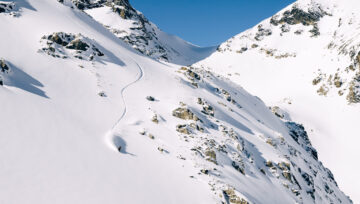Avalanche Canada: Deep Persistent Slab Not Going Away
This year’s avalanche season is plagued by a deeply buried weak layer across much of western Canada, making it one of the most difficult snowpacks to safely manage in decades. The layer of concern formed in November and is buried near the base of the snowpack, which means it varies from over 1 m deep in the Rockies to over 3 m deep in the Columbia and Coast Mountains. This weak layer has caused many high-consequence avalanches since its formation and has already claimed numerous lives.
Where the deeply buried weak layer exists
The map below highlights the most likely portion of western Canada where the deep persistent slab avalanche problem exists. Since the layer is deeply buried, there are some terrain features that make it more likely for humans to trigger it. These include:
• Steep terrain where the snowpack is shallow
• Rocky start zones in the alpine
• Wind affected terrain near ridge crests
• Areas where the snowpack transitions from thin-to-thick
We’ve also already seen many large avalanches on reloaded bed surfaces. This means that slopes that previously avalanched this season have the capacity to produce more large avalanches when reloaded with new snow. This is important, as it tells us that this buried weak layer can survive multiple avalanche cycles. It means that knowing that a slope already had an avalanche on it does not mean that the slope is safe.

How long the problem will last
The layer is deep enough that it isn’t likely to substantially change in strength before the avalanche season ends, meaning we should expect this deep persistent slab problem to remain for the coming months. We will likely have to wait until the snowpack undergoes major changes in spring and summer months, and accept that the problem could exist into summer months at high elevations where the snowpack remains cold.
What will change the likelihood of deep persistent slab avalanches
The likelihood of naturally triggered and human triggered avalanches occurring on the buried layer will change as the season progresses. The primary conditions to watch out for include periods of rapid loading from snowfall, wind, or rain, and periods of prolonged or intense warming.
Rapid loading from snow, rain, or wind-transported snow stresses the snowpack, including this deeply buried layer. These conditions also increase the likelihood of smaller avalanches releasing, which could step down to the deep weak layer and cause very large, destructive avalanches. We saw many very large avalanches (size 3 to 4) release in the past few weeks under stormy conditions and we expect this trend to continue for the remainder of the season.
Warm air temperature and sunny skies also modify the snowpack. Warming affects the snowpack by reducing its strength and increases stress on buried layers. Warming also affects how deep a human’s stress reaches into the snowpack. When human stresses reach buried weak layers, they can trigger avalanches. The influence of warming is greatest where the snowpack is inherently thin, and this is also where stresses from a human are most likely to trigger this layer. Warming also causes cornices to weaken and release, which could provide the large load needed to trigger the deep weak layer.
Regardless of trigger type, we expect to see many consequential avalanches releasing on the buried weak layer as we transition to spring conditions.

How to manage the problem
We must acknowledge that this snowpack exists and we can’t change that. What we can change is how we manage the terrain to limit the likelihood of being caught in a high-consequence avalanche. This means understanding where you stand with respect to avalanche terrain and being disciplined with any terrain choices. Experienced riders are making a point of avoiding consequential terrain, particularly exposed or rocky alpine start zones where triggering this buried weak layer is most likely.
Your mindset going into the mountains should be that this is not the season for high-consequence objectives. Be the critical thinker in the group during any decision, stay disciplined, and please have a safe remainder of this avalanche season.
By Mike Conlan, Avalanche Forecaster










Comments